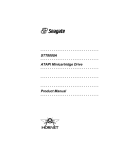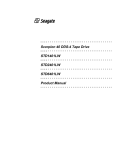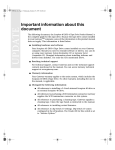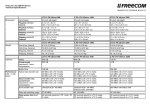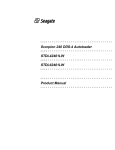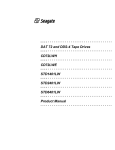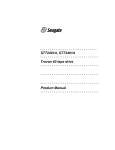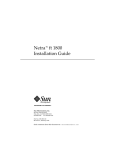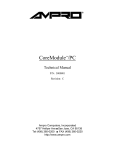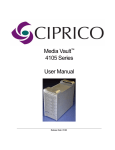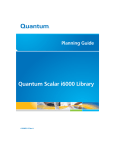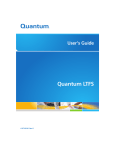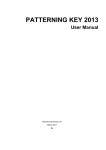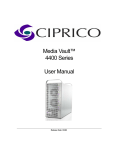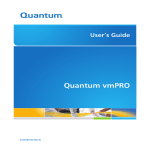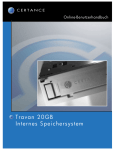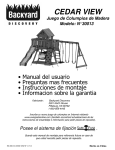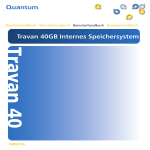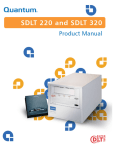Download Quantum Travan 20 SCSI User's Manual
Transcript
............................... STT20000N, STT20000N-C ............................... SCSI Minicartridge Drives ............................... (standard and NS-20 versions) ............................... ............................... Product Manual ............................... © 1998 Seagate Technology, Inc. All rights reserved No part of this publication may be reproduced in any form without written permission from Seagate Technology, Inc. Publication Number 10005135-001, March 1998 Seagate, Seagate Technology, the Seagate logo and Sidewinder are trademarks or registered trademarks of Seagate Technology, Inc. Other product names are trademarks or registered trademarks of their owners. Seagate reserves the right to change, without notice, product offerings or specifications. Seagate Technology provides this manual "as is," without warranty of any kind, either expressed or implied, including, but not limited to, the implied warranties of merchantability and fitness for a particular purpose. Seagate Technology assumes no responsibility for the accuracy, completeness, sufficiency, or usefulness of this manual, nor for any problem that might arise from the use of the information in this manual. FCC Notice This equipment generates and uses radio frequency energy and, if not installed and used properly—that is, in strict accordance with the manufacturer's instructions—may cause interference to radio communications or radio and television reception. It has been tested and found to comply with the limits for a Class B computing device in accordance with the specifications in Part 15 of FCC Rules, which are designed to provide reasonable protection against such interference in a residential installation. However, there is no guarantee that interference will not occur in a particular installation. If this equipment does cause interference to radio or television reception, which can be determined by turning the equipment on and off, you are encouraged to try to correct the interference by one or more of the following measures: • Reorient the receiving antenna. • Relocate the computer with respect to the receiver. • Move the computer into a different outlet so that the computer and receiver are on different branch circuits. If necessary, you should consult the dealer or an experienced radio/television technician for additional suggestions. You may find the following booklet prepared by the Federal Communications Commission helpful: How to Identify and Resolve Radio-TV Interference Problems This booklet (Stock No. 004-000-00345-4) is available from the U.S. Government Printing Office, Washington, DC 20402. Caution. Changes or modifications made to this equipment which have not been expressly approved by Seagate Technology may cause radio and television interference problems that could void the user's authority to operate the equipment. Further, this equipment complies with the limits for a Class B digital apparatus in accordance with Canadian Radio Interference Regulations. Cet appareil numérique de la classe B est conforme au Règlement sur brouillage radioélectrique, C. R. C., ch. 1374. Additional warnings: • To prevent fire or electrical shock hazard, do not expose the unit to rain or moisture. • To avoid electrical shock, do not open the cabinet. Refer servicing to qualified personnel. Important Information About This Manual All information contained in or disclosed by this document is considered proprietary by Seagate Technology. By accepting this material, the recipient agrees that this material and the information contained therein are held in confidence and in trust and will not be used, reproduced in whole or in part, nor its contents revealed to others, except to meet the purpose for which it was delivered. It is understood that no right is conveyed to reproduce or translate any item herein disclosed without express written permission from Seagate Technology. Seagate Technology provides this manual "as is," without warranty of any kind, either expressed or implied, including, but not limited to, the implied warranties of merchantability and fitness for a particular purpose. Seagate Technology reserves the right to change, without notification, the specifications contained in this manual. Seagate Technology assumes no responsibility for the accuracy, completeness, sufficiency, or usefulness of this manual, nor for any problem that might arise from the use of the information in this manual. Table of Contents Table of Contents Introduction 1 Drive overview ........................................................................................................ 1 Features ................................................................................................................. 4 Typical system configurations ................................................................................. 5 Minicartridge technology overview........................................................................... 5 Flash EEPROM ...................................................................................................... 6 Software ................................................................................................................. 6 References ............................................................................................................. 6 About this manual ................................................................................................... 7 Specifications 9 Overview ................................................................................................................ 9 Physical specifications ............................................................................................ 9 Power specifications ............................................................................................. 11 Drive performance specifications .......................................................................... 12 Environmental requirements ................................................................................. 13 Reliability .............................................................................................................. 14 Mean-Time-Between Failures ......................................................................... 14 Mean-Time-To-Repair .................................................................................... 14 Recommended tapes............................................................................................ 15 Regulatory compliance.......................................................................................... 15 Installation 17 Introduction........................................................................................................... 17 Handling guidelines............................................................................................... 17 Installation overview.............................................................................................. 17 Setting jumpers..................................................................................................... 18 SCSI device address jumpers................................................................... 19 Parity ....................................................................................................... 19 SCSI terminator enable ............................................................................ 19 Terminator power ..................................................................................... 20 Installing the drive................................................................................................. 21 Mounting dimensions ............................................................................................ 22 Cabling and connectors ........................................................................................ 23 Electrical characteristics ........................................................................... 24 Single-ended SCSI connector......................................................................... 25 STT20000N Product Manual Page v Table of Contents Drive operation and maintenance 27 Introduction........................................................................................................... 27 Front panel LED operation .................................................................................... 27 Using Travan cartridges ........................................................................................ 28 Loading and unloading tape cartridges............................................................ 28 Setting the write–protect switch ...................................................................... 29 Loading revised firmware from a Seagate firmware cartridge ................................ 29 Drive maintenance ................................................................................................ 30 Caring for tape cartridges ............................................................................... 30 Cleaning the drive read/write head.................................................................. 31 Troubleshooting .................................................................................................... 32 SCSI Interface 33 Introduction........................................................................................................... 33 SCSI-1 interface ................................................................................................... 33 SCSI-1 status codes....................................................................................... 33 SCSI-1 message codes .................................................................................. 34 SCSI-1 commands ......................................................................................... 35 ANSI X3.131 CONFORMANCE STATEMENT (SCSI-1) ....................................... 36 General features............................................................................................. 36 Commands..................................................................................................... 36 Messages....................................................................................................... 37 Vendor-unique commands .............................................................................. 37 SCSI-2 interface ................................................................................................... 37 SCSI-2 status codes....................................................................................... 37 SCSI-2 message codes .................................................................................. 38 SCSI-2 commands ......................................................................................... 38 ANSI X3.T92 conformance statement (SCSI-2) .................................................... 40 SCSI-2 general features ................................................................................. 40 SCSI-2 commands ......................................................................................... 40 SCSI-2 messages........................................................................................... 41 SCSI-2 vendor-unique commands .................................................................. 41 Command set changes to Incorporate RWW and HDC ......................................... 42 Read-While-Write ........................................................................................... 42 Log Sense Write Error Counts page code (02h)........................................ 42 Hardware data compression ........................................................................... 43 Mode Select / Mode Sense Data Compression page code (0Fh) .............. 43 Parameters that control data compression................................................ 44 Page vi STT20000A Product Manual Table of Contents Tape format 45 Introduction........................................................................................................... 45 Tape partitioning ................................................................................................... 45 Track positions ..................................................................................................... 45 Track numbering................................................................................................... 46 Track format ......................................................................................................... 46 Frames........................................................................................................... 46 Blocks ............................................................................................................ 48 Tape reference servo pattern ................................................................................ 48 Write equalization ................................................................................................. 49 Randomization...................................................................................................... 49 Theory of operations 51 Overview .............................................................................................................. 51 Drive configurations .............................................................................................. 51 Block diagrams ..................................................................................................... 51 Mechanics ............................................................................................................ 53 Cartridge load mechanism .............................................................................. 53 Capstan drive motor assembly........................................................................ 53 Chassis .......................................................................................................... 53 Control circuits ...................................................................................................... 53 Head design ......................................................................................................... 54 Flash EEPROM .................................................................................................... 54 Sensors and switches ........................................................................................... 54 Media (Travan minicartridges)............................................................................... 55 Read-While-Write ................................................................................................. 56 ALDC data compression ....................................................................................... 56 Glossary 57 Acronyms and units of measurement 60 Acronyms and abbreviations ................................................................................. 60 Units of measurement........................................................................................... 62 STT20000N Product Manual Page vii Table of Contents Notes Page viii STT20000A Product Manual Introduction Chapter 1 1 Introduction Drive overview The Seagate internal STT20000 SCSI minicartridge drive extends the Seagate family of one-inch high, DC2000 drives that feature high performance, high reliability, and quiet operation. The STT20000 SCSI minicartridge drive transfers data at up to 60 megabytes per minute (Mbtyes/min) without data compression. With optimal system resources available, and with compressible data structures, nominal transfer rates of up to 120 Mbytes/min can be observed using software data compression (assumes 2:1 compression ratio). An additional feature of the STT20000 SCSI minicartridge drive is an option for Read While Write and Hardware data Compression. These features are available on the NS series (STT20000N-C). Highlights of these features are contained in various parts of this Product Description Manual. Optimal system resources include but are not limited to: • Allocating the maximum amount of the base 640-Kbyte memory available • Not using a memory manager program Note: During backup tasks, screen savers can have a negative affect on transfer rates. Data compression is available within the Seagate Backup Exec software package for DOS and Windows and typically provides for a 2:1 compression ratio. The compression ratio is dependent on the specific system and the nature of the files being compressed. Using FastSenseTM, a unique Seagate feature, the STT20000 SCSI minicartridge drive automatically senses the fastest available data transfer rate of the host system and selects from three discrete speeds: 1,000, 733, or 489 kilobytes/second (Kbyte/sec). This process maximizes system throughput by eliminating tape repositioning, which is typically required when the tape drive operates faster than the host computer. The product is available as an internal device in either a 3.5-inch or 5.25-inch configuration. The internal drive form factors are tailored for easy installation in today's computers, and the full-featured embedded SCSI controller facilitates easy integration into a variety of systems. The drive contains an embedded, single-ended Small Computer Systems Interface (SCSI) controller that supports SCSI (ANSI X3.131, 1986) and SCSI-2 (ANSI X3.T92). The drive supports numerous popular SCSI controller boards and embedded devices including those from Adaptec and DPT. The drive provides synchronous or asynchronous SCSI and a high speed burst rate of 5 Mbyte/second. STT20000N Product Manual Page 1 Chapter 1 Introduction The drive is equipped with a 512-Kbyte on-drive buffer to facilitate efficient operation. The STT20000 SCSI minicartridge drive supports the QIC-3220-MC format standard and will provide 10 gigabytes uncompressed storage capacity, 20 gigabytes compressed, with a Travan TR-5 cartridge. The drive will also read tapes conforming to the QIC-3095 standard (TR-4). A precision-burst intelligent positioning system is used to achieve high track densities. The STT20000 SCSI minicartridge drive conforms to the QIC-3220-MC development standard adopted by Quarter-Inch Cartridge Drive Standards Inc. (QIC). The drive records in a serpentine fashion utilizing a 1,7 RLL (Run Length Limited) data encoding method, and provides for 108 data tracks and one (1) directory track on Travan TR-5 media. The drive offers electronically erasable, programmable, read-only memory (flash EEPROM), which enables qualified Seagate OEMs to download revised firmware to the drive. With the availability of greater capacity disk drives and the growth of small networks, the need for cost-effective, high-capacity SCSI-storage has grown. The STT20000 SCSI minicartridge drives are ideal for high-end stand-alone computers, workstations, and small networks. Built using long-wearing materials and custom Large Scale Integration (LSI) components, the drive was engineered for heavy-duty computer applications. Providing carefully controlled tape handling and rapid, smooth operation, the drive design promotes long life for key components such as the motors, drive heads, and the media itself. One major benefit of this new, computer grade engineering is low power consumption. Figure 1-1 illustrates the internal drive in 3.5-inch configuration. Figure 1-2 illustrates the internal drive in 5.25-inch configuration (with mounting brackets). Page 2 STT20000A Product Manual Introduction Chapter 1 Figure 1-1 STT20000 SCSI minicartridge internal drive (3.5-inch mounting configuration) Figure 1-2 STT20000 SCSI minicartridge internal drive with mounting brackets (5.25-inch mounting configuration) STT20000N Product Manual Page 3 Chapter 1 Introduction Features The STT20000 SCSI minicartridge drive embodies Seagate 's commitment to engineer reliable and durable tape drive products. In summary form, key features of the drive are as follows: Page 4 • Internal form factor for installation in a 5.25-inch half-high or 3.5-inch by oneinch space • Capability to write and read Travan TR-5 (QIC-3220-MC) • QIC-3220-MC tape format compliance for compatibility and information interchange • Typical uncompressed capacities of up to 10 gigabytes on 740 foot TR-5 media • Typical compressed capacities of up to 20 gigabytes on 740 foot TR-5 media • Transfer rate optimized with FastSenseTM—automatic selection of fastest supportable data transfer rate (1,000, 733, or 489 Kbyte/sec) • Single-ended SCSI connection with these features: • Embedded full LSI, high speed SCSI controller • Software selectable synchronous or asynchronous SCSI data transfer • High performance SCSI burst transfer rate of 5 Mbyte/sec with 512 Kbyte (2 Mbyte on the STT20000N-C NS-20 drive) on-drive data buffer to facilitate the most efficient use of the host computer and tape drive • Reed-Solomon ECC (error correction code) with un-correctable error rate of less 15 than 1 in 10 bits • Flash EEPROM to enable electrically upgradable drive firmware • Custom Seagate -designed LSI circuitry to reduce component count and boost drive reliability • Low power consumption- less than 15.0 Watts (typical) for internal drives • Extensive set of motion commands that enables the drive to support either streaming or file-oriented dump and restore modes • Compatibility with a wide range of PCs STT20000A Product Manual Introduction Chapter 1 Typical system configurations The SCSI standard supports up to eight SCSI addresses or IDs. These IDs refer to host adapters or peripheral devices such as printers, magnetic disks, or tape drives. The eight devices or hosts are daisy chained together. Figure 1-3 shows sample configurations of SCSI systems. Figure 1-3 SCSI system—sample configurations COMPUTER SYSTEM HOST ADAPTER SCSI BUS SCSI TAPE DRIVE COMPUTER SYSTEM HOST ADAPTER SINGLE INITIATOR - SINGLE TARGET COMPUTER SYSTEM HOST ADAPTER SCSI BUS SCSI TAPE DRIVE MAGNETIC DISC, PRINTER, or OPTICAL DISK SCSI BUS MAGNETIC DISC, PRINTER, or OPTICAL DISK SINGLE INITIATOR - MULTIPLE TARGET MAGNETIC DISC, PRINTER, or OPTICAL DISK SCSI TAPE DRIVE COMPUTER SYSTEM HOST ADAPTER MAGNETIC DISC, PRINTER, or OPTICAL DISK MULTIPLE INITIATOR - MULTIPLE TARGET Minicartridge technology overview Having evolved from the original mass-storage medium—reel-to-reel, 1/2-inch tape storage- the minicartridge technology of today offers fast, efficient, high-capacity storage in a compact, easy-removable hard-shell package. In little more than a decade, storage capacities have increased from some 60 megabytes (Mbyte) on 9 tracks (QIC-24, 1982) to the 20-Gbyte capacity achievable with the STT20000 SCSI minicartridge drive on a single Travan TR-5 cartridge. The streaming-tape intelligence in this minicartridge drive provides a continuous tape motion with an uninterrupted, precisely coordinated flow of data to and from the minicartridge. This "streaming" motion combined with the "serpentine" recording method is one element that contributes to the increased storage capacities, efficiency, and speed of today's minicartridge technology. Use of the "serpentine" recording method exploits the bi-directional capabilities of the cartridge. With this method, the tape is not rewound at the end of a track. Instead, the write-read heads are logically or mechanically switched to a different position on the tape and another track is written or read in the reverse direction. That is, the drive first records track 1 in one direction and when the end of the tape is reached, the head is moved and the direction of tape motion is reversed to record a second track This serpentine process continues until the entire tape is recorded. The individual tracks are sequential to minimize the amount of head motion as the heads change position for each track. STT20000N Product Manual Page 5 Chapter 1 Introduction Flash EEPROM The STT20000 SCSI minicartridge drive incorporates leading-edge technology in the flash EEPROM, which is useful should the drive's SCSI firmware need to be upgraded at some point. With the permanently installed electrically up-gradeable flash EEPROM memory, revised SCSI firmware for the drive can be loaded via any one of two methods: • Seagate OEM firmware cartridge (See Chapter 4) • Host SCSI bus This feature enables qualified OEMs needing to revise the drive firmware to do so rapidly and at a reduced cost. Flash EEPROM should also prolong the life cycle of a drive because many new techniques—such as increasing the capacity of the drive through support for longer tapes—may require only a firmware upgrade. Software The STT20000 SCSI minicartridge drive is a cost-effective means of backing up fixed disks. The software required to perform a disk backup runs under the control of the host computer's operating system. Compatibility with a wide range of software is also an important consideration in system integration. The drive requires any one of the following operating environments: DOSTM version 5.0 or later, Microsoft WindowsTM 3.1 or later, Microsoft Windows 95, or Windows NT. The drive operates with many of the popular backup software applications such as Seagate 's Backup Exec for DOS and Windows, Windows 95, Netware, or Windows NT. References The following standards documents describe some of the technology incorporated in the drives referenced in this manual. Page 6 • QIC-121—Implementation of Small Computer System Interface (SCSI-2) for QIC-Compatible Sequential Storage Devices • QIC-104— Implementation of Small Computer System Interface for QICCompatible Sequential Storage Devices • ANSI X3.127-1987—Unrecorded Magnetic Tape Minicartridge for Information Exchange: 0.250-inch. • ANSI X3T9.2/86-109—Specifies the Small Computer System Interface-2 (SCSI-2). • QIC-170—Preformatted magnetic minicartridge • QIC-3095-MC—Serial recorded magnetic tape minicartridge • QIC-3220-MC—Serial recorded magnetic tape minicartridge STT20000A Product Manual Introduction Chapter 1 For more information about a particular QIC standard, contact Quarter-Inch Cartridge Standards, Inc., c/o Freeman Associates, 311 East Carrillo Street, Santa Barbara, California 93101. About this manual The remaining chapters and the appendices in this manual are briefly described in the following table. A glossary of terms is also included. Number Title Description 2 Specifications Contains physical, performance, environmental, power, and reliability specifications for the drive and minicartridges. 3 Installation Provides cautions, unpacking tips, inspection information, and installation/connection steps including cabling requirements and connector pinouts. 4 Drive operation Explains drive operation, maintenance and troubleshooting 5 SCSI interface Lists general information about the SCSI interface. (See Note below.) 6 Tape format Provides an overview of the QIC3220-MC tape format. 7 Theory of operation Details the functional operation of various assemblies of the SCSI drive. Appendix A Glossary Defines key terms. Appendix B Acronyms and Measurements Lists the acronyms and measurements used in the manual. Note: STT20000N Product Manual This manual provides all technical information about the STT20000 SCSI minicartridge drive for hardware and software development and integration except complete SCSI information on the SCSI commands themselves. Refer to the SCSI Minicartridge Drive SCSI Manual (P/N 10001652-002) for detailed information about the SCSI interface, including a complete command summary. Page 7 Chapter 1 Introduction Notes Page 8 STT20000A Product Manual Specifications Chapter 2 Specifications 2 Overview The STT20000 SCSI minicartridge drive provides exceptional reliability in storing large amounts of computer data. This chapter includes the following specifications and requirements: • Physical specifications • Power requirements • Drive performance specifications • Environmental requirements • Recommended tapes • Tape capacities and formats • Regulatory compliance Physical specifications The physical specifications of the STT20000 SCSI minicartridge drive are listed in the following table. Specification Drive for 3.5-Inch Mount Drive for 5.25-Inch Mount Height 1.0 in/ 25 mm 1.7 in/ 43 mm Width 4.0 in/102 mm 5.87 in/149.1 mm Length 6.2 in/157.5 mm 6.36 in/161.5 mm Weight 1.0 lbs/0.5 kg 1.5 lbs/0.7 kg Figures 2-1 and 2-2 show the general dimensions of the STT20000A in 3.5-inch configuration (without mounting brackets) and in the 5.25-inch configuration (with mounting brackets). STT20000N Product Manual Page 9 Chapter 2 Specifications Figure 2-1 STT20000N (3.5-Inch mount)—general dimensions 4.00 in (101.6 mm) 6.36 in (161.5 mm) 0.157 in (4 mm) 4.00 in (101.6 mm) 1.00 in (25.4 mm) Figure 2-2 STT20000N (5.25-Inch mount)—general dimensions 0.86" (21.8mm) 5.49" (139.4mm) 5.76" (146.4mm) 0.20" (5.0mm) 5.87" (149.0mm) DRIVE ACTIVE (GREEN) Page 10 1.685" (42.8mm) STT20000A Product Manual Specifications Chapter 2 Power specifications The following table lists the power specifications for the STT20000 SCSI minicartridge drive. (Power specifications are measured at the tape drive power connector and are nominal values.) Specification Measurement DC Voltage +12 VDC +5 VDC Voltage Tolerance ± 10% ± 5% Operational Current 2.0 amps 1.0 amp Standby Current 0.2 amp 0.6 amp Peak 2.2 amps max — Power Sequence None None Ripple (peak to peak) ≤100 mV ≤100 mV Power use (nominal) < 15 Watts (excluding surge) < 15 Watts (excluding surge) The following table lists pin assignments for the power connector for the drive. STT20000N Product Manual Pin Assignment 1 +12 VDC 2 +12 return 3 +5 return 4 +5 VDC Page 11 Chapter 2 Specifications Drive performance specifications The following table lists the performance specifications for the STT20000 SCSI minicartridge drive. Feature Specification Capacity 10.0 gigabytes—1650 Oe 740' Travan cartridge (uncompressed) 20.0 gigabytes—1650 Oe 740' Travan cartridge (compressed) Effective backup rate up to 60 Mbyte/min typical native; up to 120 Mbyte/min typical compressed Data transfer rate 489 / 733 / 1,000 Kbyte/second FastSense Tape speed Read/Write Search/Rewind 46,70, or 94 ips 90 ips maximum Recording method Serpentine Recording format QIC-3220-MC Recording code 1,7 RLL Error recovery Reed Solomon ECC TM Recording unrecoverable Less than 1 in 1015 data bits errors Page 12 Head configuration Wide write/narrow read Recording media 1650 Oe 740' Travan TR-5 Cartridge size 3.2 in. x 2.4 in. x 0.4 in. (81 mm x 61 mm) Data density 100,400 bpi Tracks 108 data tracks, one (1) directory track Synchronous transfer rate (burst) 5 Mbytes/second maximum Asynchronous transfer rate (burst) 5 Mbytes/second maximum STT20000A Product Manual Specifications Chapter 2 Environmental requirements The following table lists the environmental specifications for the STT20000 SCSI minicartridge drive. The drive may be mounted either vertically or horizontally. Specification Operational Non-operational Temperature +41° to +113° F1 (+ 5° to + 45° C) –40° to +149° F2 (–40° to + 65° C) Thermal gradient 1° C/minute (no condensation) 20° C/hour Relative humidity 20% to 80% noncondensing1 5% to 95% noncondensing2 Maximum wet bulb temperature 78.8° F (26° C) No condensation Altitude –1,000 to +15,000 feet –1,000 to +50,000 feet 0.005 in max. (5 to 44.3 Hz) 0.1 in max. (5 to 17 Hz) Vibration Peak to Peak Displacement Peak Acceleration 0.50 g max. (44.3 to 500 Hz) 1.5 g max. (17 to 500 Hz) Acoustic level operational (A-wt sum) 55 dBA maximum (measured in suitable enclosure at 3-ft distance and operator height) — Shock (1/2 sine wave) 2.5 g’s peak, 11 msec 100 g's peak, 11 msec 1 Specification applies to drive mechanism and media 2 Specification applies to drive mechanism only STT20000N Product Manual Page 13 Chapter 2 Specifications Reliability The STT20000 SCSI minicartridge drive is designed for maximum reliability and data integrity. The following table summarizes the reliability specifications. Feature Specification Non-recoverable error rate < 1 in 10 Error recovery and control Reed-Solomon Error Correction Code techniques 15 bits Error monitoring and reporting (Error Log) Media pre-written Retry on read Data randomization Mean-Time-Between-Failures (MTBF) Greater than 250,000 hours Mean-Time-To-Repair (MTTR) Less than 0.33 hour Mean-Time-Between Failures The Mean-Time-Between Failures (MTBF) is greater than 200,000 hours. This specification includes all power-on and operational time but excludes maintenance periods. Operational time is assumed to be 20% of the power-on time. Operational time is the time the tape is loaded. MTBF is highly dependent on operational time, as operational time increases above 20% of the power on time the MTBF is reduced, conversely as the operational time is reduced the MTBF increase, as an example at a operational duty cycle of 12% the STT20000 MTBF can equal 250,000 hours. Note: Seagate does not warrant the stated MTBF as representative of any particular unit installed for customer use. The failure rate quoted here is derived from a large database of test samples. Actual rates may vary from unit to unit. Mean-Time-To-Repair The Mean-Time-To-Repair (MTTR) is the average time required by as qualified service technician to diagnose a defective drive and install a replacement drive. The MTTR for the drive is less than 0.33 hour (20 minutes). The STT20000 SCSI minicartridge drive is a field replaceable unit. If a problem occurs with a subassembly or component in the drive, the entire unit should be replaced. The faulty drive should be returned to the factory in its original packaging. Contact your distributor, dealer, your computer system company, or your Seagate sales representative to arrange the return. Page 14 STT20000A Product Manual Specifications Chapter 2 Recommended tapes The STT20000 SCSI minicartridge drive uses pre-written minicartridges. Description Seagate Travan (740 ft) (QIC-3220) 10.0 Gbyte capacity (20.0 Gbyte capacity with data compression) 20000TT Note. The STT20000 SCSI minicartridge drive reads and writes the QIC-3220-MC format. The STT20000 SCSI minicartridge drive reads but does not write the QIC-3095-MC format. Regulatory compliance The STT20000 SCSI minicartridge drive complies with the regulations listed in the following table. Agency Regulation CSA C22.2, No. 950-M89 TUV & IEC-RHEINLAND EN 60 950/IEC 950 UL 1950 Canadian Dept. of Communications Class B EN55022 (CISPR-22) with additional CE Mark test req. Class B FCC Class B, Part 15 Use the STT20000 SCSI minicartridge drives only in equipment where the combination has been determined to be suitable by an appropriate certification organization (for example, Underwriters Laboratories Inc. or the Canadian Standards Association in North America). You should also consider the following safety points. • Install the drive in an enclosure that limits the user's access to live parts, gives adequate system stability, and provides the necessary grounding for the drive. • Provide the correct voltages (+5 VDC and +12 VDC) based on the regulation applied—Extra Low Voltage (SEC) for UL and CSA and Safety Extra Low Voltage for BSI and VDE (if applicable). STT20000N Product Manual Page 15 Chapter 2 Specifications Notes Page 16 STT20000A Product Manual Installation Chapter 3 3 Installation Introduction This chapter tells you how to install the STT20000 SCSI minicartridge drive. The following paragraphs briefly outline the organization of this chapter. • The following section, Before You Begin contains general information that you should read before you begin the installation. • Installing the Internal Drive lists guidelines for handling the internal drive, describes the cabling and connectors, explains how to configure the drive, and provides directions for mounting the drive unit. Handling guidelines Because the drive unit can be damaged by electrostatic discharge, an electrostatic grounding strap is recommended. This strap prevents an electrostatic discharge from damaging the electronic components on the board or in the drive unit If you do not have an electrostatic grounding strap, perform the installation at a static-safe workstation. If one is not available, follow these guidelines as you install the interface card and drive unit: • Work in an uncarpeted area. • To protect the drive and interface card from static electricity, DO NOT remove either the drive or the card from its anti-static bag until you are ready to install it. • Before you remove the drive or card from the anti-static bag, touch a metal or grounded surface to discharge any static electricity buildup from your body. Caution: If you touch static-sensitive parts of the drive (such as the printed circuit board) elecronic components may be damaged. • Hold the drive by its edges only and avoid direct contact with any printed circuit board exposed. • Lay the drive only on top of the anti-static bag or return it to its bag when you need to lay the drive down. Installation overview The drive mounts internal to the computer in either a 3.5-inch by one-inch space or in a 5.25-inch half-high space with the use of mounting brackets. STT20000N Product Manual Page 17 Chapter 3 Installation Three simple steps make up the installation procedure: 1. Configure jumpers. 2. Mount the drive unit. 3. Complete the power and interface connections. The installation procedure is the same for both models except physically mounting the unit in the computer. After you configure the jumpers and decide whether or not you need to add terminators, follow the steps provided for the size of enclosure into which you are mounting the drive. Setting jumpers Figure 3-1 illustrates the location of the jumpers on the bottom of the drive. Figure 3-1 Location of drive jumpers NOTE: Bottom of drive shown. JUMPER BLOCK PIN 1 SCSI CONNECTOR POWER CONNECTOR SCSI PIN 1 The following settings should be checked prior to installation. Figure 3-2 shows the jumper configurations for the various SCSI device addresses (IDs) and for the other options. • SCSI ID • Parity • Terminator power • Termination Use the jumpers to set the SCSI device address. You can also enable parity and enable terminator power by jumper placements. SCSI terminators must be installed for the last device on the SCSI bus. Page 18 STT20000A Product Manual Installation Chapter 3 Figure 3-2 Jumper configurations 15 13 11 9 7 5 3 1 16 14 12 10 8 6 4 2 JUMPER ON JUMPER OFF SCSI ID PARITY ENABLED JUMPER 7-8 ON RESERVED RESERVED ACTIVE TERMINATION JUMPER 13-14 ON TERMINATOR POWER ENABLED JUMPER 15-16 ON PIN PIN PIN 5 6 3 4 1 2 OFF OFF OFF OFF ON ON ON ON OFF OFF ON ON OFF OFF ON ON OFF ON OFF ON OFF ON OFF ON SCSI ID 0 1 2 3 4 5 6 7 Notes: In Figure 3-2, ON means that the jumper shunt is placed over the two vertical pins. OFF means that the jumper shunt is removed from the two vertical pins (or hanging over only one of the pins). The drive must be turned OFF; then, ON in order for the jumper placements to take effect, or a SCSI Bus Reset must be received. If the default address setting ID is correct for your system, and you do not choose to change any other options, go to the following section that explains how to install the drive unit. If you need to change any default settings, refer to Figure 3-2 and the appropriate following section; make the changes and then go to the following section that explains how to install the drive unit. SCSI device address jumpers Be sure that no other device on the SCSI bus has the same SCSI address. Figure 3-2 shows the jumper placements for the various SCSI ID choices. Parity To enable parity, place a jumper shunt over the two pins—7 and 8—as shown in Figure 3-2. Be sure the jumper shunt is firmly in place. SCSI terminator enable The last device on the SCSI bus must have termination. Figure 3-3 illustrates the termination for two daisy-chain configurations. STT20000N Product Manual Page 19 Chapter 3 Installation Figure 3-3 Daisy-chain configurations 1 2 SCSI Host Adapter (terminated) SCSI Tape drive (not terminated) other SCSI device (terminated) other SCSI device (not terminated) SCSI Tape drive (terminated) SCSI Host Adapter (terminated) The STT20000 SCSI minicartridge drive supports active termination and does not require the use of terminating resistor packs. Terminator power Terminator power (+5-volt) is enabled by default. Caution: If the jumper is installed, be careful not to short the TERMPWR signal to ground. The drive contains a terminator power fuse to prevent damage to drive components in case the terminator power is shorted. If terminator power is enabled and the SCSI cable is connected upside down for example, this fuse may blow to prevent damage to the drive itself. In that case, return the drive to an authorized repair facility. Page 20 STT20000A Product Manual Installation Chapter 3 Installing the drive The following steps guide you through installing the internal Travan drive. Caution: Note: Turn off your computer before you begin the installation. Failure to do so might result in damage to your equipment or electrical shock to you. Because computer models vary between manufacturers, refer to your computer manual for specific installation instructions. 1. Write down the serial number and model number shown on the drive and put this information in a safe place. You need this information if you ever call for service. 2. Refer to the manual that you received with your computer for instructions about removing the computer cover and the face plate from the drive bay in which you plan to install the drive. Note: If devices are installed in any drive bays adjacent to the one you are using for the internal drive, partially removing those devices might give you more working space. 3. Check that jumper settings and termination are correct for your installation. (Refer to the previous text under Configuring the Drive.) 4. Attach any special mounting hardware to the drive that your system might require. Refer to the manual that you received with your computer for requirements. 5. Locate the mounting screw holes in the drive brackets. Each side contains two sets of holes. Use the set that aligns the drive properly within the drive bay. 6. Slide the tape drive into the computer so that the drive bezel and the computer face plate are flush. Then, align the mounting holes. 7. Secure the drive using the mounting screws. The threaded mounting holes are designed for M3.0 metric screws. The maximum length for the M3.0 metric screws is 4 mm. Use of longer length screws may damage the drive. See following section for mounting dimensions. 8. Connect an available power cable to the power connector on the drive. The recommended power mating connector requires an AMP 1-48024-0 housing with AMP 60617-1 pins or equivalent. Note: Turn off all power before inserting connectors. 9. Connect the mating SCSI connector (the single-ended connector described previously in Cabling and Connectors) with the SCSI connector on the rear of the unit. When you make the connection, be sure pin 1 of the connector aligns with pin 1 on the SCSI connector. STT20000N Product Manual Page 21 Chapter 3 Installation Pin 1 on the SCSI connector is to your right as you look at the back of the drive. (See Figure 3-1.) Your SCSI cable should have Pin 1 highlighted by a color strip. Be sure to mate Pin 1 on the cable to Pin 1 on the drive. Failure to do so could make the drive inoperative. Note: 10. Replace the computer cover and reconnect any peripherals that you disconnected during the installation. Mounting dimensions Figures 3-4 and 3-5, respectively, illustrate the location of the mounting holes for the internal drive without and with mounting brackets. Figure 3-4 Mounting hole locations for internal drive 0.2 in (5 mm) 3.7 in (94 mm) 0.315 in (8 mm) 2.758 in (70 mm) 3.543 in (90 mm) 6.36 in (161.5 mm) 2.382 in (60 mm) 1.220 in (31 mm) 0.984 in (25 mm) 4.0 in (102.6 mm) Page 22 0.157 in (4 mm) 1.0 in (25.4 mm) STT20000A Product Manual Installation Chapter 3 Figure 3-5 Mounting hole locations for drive with mounting brackets 0.4 in (10.2mm) 0.62 in (15.7mm) 0.86 in (21.8mm) .075 in (1.9mm) 2 PLACES 5.76 in (146.4mm) 3.12 in (79mm) 3.12 in (79,2mm) 5.49 in (139mm) 2.36 in (60mm) 2.08 in (53mm) 1.81 in (45.9mm) 5.87 in (149.0mm) 0.197 in (5mm) 1.7 in (43mm) 0.51 in (13.0mm) Cabling and connectors The drive provides standard, single-ended SCSI transmission. ANSI SCSI standards specify the technical requirements for correctly cabling and connecting single-ended devices. Either 50-pin flat cable or 25-signal twisted-pair cable with a maximum length of 6 meters (19 feet) may be used to connect the drive to its SCSI host adapter output. If twisted-pair cabling is used, connect the twisted pairs to physically opposing contacts on the connector. A stub length no greater than 0.1 meter should be used off the mainline connection within any connected equipment. STT20000N Product Manual Page 23 Chapter 3 Installation The cable characteristic impedance should not be less than 90 ohms nor greater than 140 ohms. A cable characteristic impedance of greater than 100 ohms is recommended. To minimize noise and ensure even distribution of terminator power, the minimum recommended conductor size is 28 AWG (0.08042 mm 2). Electrical characteristics This section lists measurements of various electrical signals in relation to the singleended SCSI connection. For these measurements, SCSI bus termination is assumed to be external to the SCSI device. All signals except GROUND and TERMPWR must be terminated at both ends of the cable. Each signal termination consists of 220 ohms (+ or -5%) to TERMPWR and 330 ohms (+ or -5%) to GROUND and must meet the following specifications: • Terminators must supply a characteristic impedance of 100 to 132 ohms. • External terminators must be powered by the TERMPWR line, and units providing terminator power to the cable must have: VTERM = 4.25 to 5.25 VDC 900 milliamps minimum source drive capability • When TERMPWR matches the above values, the voltage of released signal lines must be at least 2.5 VDC. • When a driver asserts a line and pulls it to 0.5 VDC, the current available to the signal line driver may not exceed 48 milliamps. The first two terminators may only supply 44.8 milliamps of this current. • When at least one device supplies TERMPWR, these conditions may be met by any valid configuration of targets and initiators. All signals use open-collector drivers. The output characteristics (measured at the connector of the drive) of signals driven by the STT20000 SCSI minicartridge drive are: • Signal assertion (low-level output voltage): 0.0 to 0.5 VDC at 48 milliamps sinking • Signal negation (high-level output voltage): 2.5 to 5.25 VDC Signals received by the STT20000 SCSI minicartridge drive have the following characteristics. Page 24 • Signal assertion (low-level input voltage): 0.0 to 0.8 VDC • Signal negation (high-level input voltage): 2.0 to 5.25 VDC • Maximum input load (low-level input current): - 0.4 at 0.5 VDC • Minimum input hysteresis: 0.2 VDC STT20000A Product Manual Installation Chapter 3 Single-ended SCSI connector The STT20000 SCSI minicartridge internal drive provides a 50-pin, right-angle, dualrow connector on the main PCB at the rear of the drive. The pin assignments for this single-ended connector are listed in the following table. Note: STT20000N Product Manual All odd pins except pin 25 are connected to signal ground at the drive. Pin 25 is left open. A signal name or abbreviation preceded by a –(dash) indicates that the signal is active-low. Pin Assignment 2 –DB(0) 4 –DB(1) 6 –DB(2) 8 –DB(3) 10 –DB(4) 12 –DB(5) 14 –DB(6) 16 –DB(7) 18 –DB(P) 20 GROUND 22 GROUND 24 GROUND 26 TERMINATOR POWER 28 GROUND 30 GROUND 32 –ATN 34 GROUND 36 –BSY 38 –ACK 40 –RST2 Page 25 Chapter 3 Page 26 Installation Pin Assignment 42 –MSG 44 –SEL 46 –C/D 48 –REQ 50 –I/O 1 The +5V drive supply is available on the SCSI connector as a terminator power option. This pin is connected to the +5V through a diode. The option is a hardware jumper on the rear PCB of internal drives with terminator power disabled as a factory default. 2 ANSI defines -RST as a bi-directional pin. On the drive, -RST is input only. STT20000A Product Manual Drive operation and maintenance Chapter 4 Drive operation and maintenance 4 Introduction This chapter describes important operational procedures for the STT20000 SCSI minicartridge drive. It covers the following topics: • Operation of the front panel LED • Using cartridges • Loading revised firmware (updating flash EEPROM) • Drive maintenance and troubleshooting Front panel LED operation The front panel of the Travan drive contains the cartridge opening and one amber, light-emitting diode (LED). This LED is lit when the tape is NOT at the beginning of the tape. Thus, the LED shows tape movement when lit. Figure 4-1 shows the front panel of the internal drive. Figure 4-1 Front panel of 3.5-inch internal drive DRIVE ACTIVE (AMBER) STT20000N Product Manual Page 27 Chapter 4 Drive operation and maintenance Using Travan cartridges The minicartridges recommended for use with the STT20000 SCSI minicartridge drive are listed in Chapter 2. This section describes some operations using the cartridges. Loading and unloading tape cartridges Your tape drive has a flip-up door that covers the cartridge opening when a tape cartridge is not installed in the drive. Once a cartridge is inserted, it is held firmly in place by the drive's positive locking mechanism. Caution: DO NOT remove a tape cartridge while the drive is active. Complete any tape operations and wait until the amber LED is OFF before removing the cartridge. To load a cartridge, insert it with the metal base plate down and the tape access door facing into the drive. Figure 4-2 illustrates the loading of a cartridge. Figure 4-2 Loading a Travan cartridge To unload a cartridge, wait until the drive activity LED is OFF and then pull the cartridge straight out. Figure 4-3 illustrates the unloading of a cartridge. Figure 4-3 Unloading a Travan cartridge Page 28 STT20000A Product Manual Drive operation and maintenance Chapter 4 Setting the write–protect switch Travan minicartridges feature a write-protect switch located in the upper left corner of the cartridge. You can set the switch to keep data from being written on the tape. Use this switch when you want to make sure that important data on the tape will not be overwritten. Figure 4-4 shows the cartridge with the switch in the non-protected (read/write) or unlocked position. Figure 4-4 Write-protect switch in unlocked position Figure 4-5 shows the tab in the protected (read only) or locked position. Figure 4-5 Write-protect switch in locked position To return a cartridge to the "writeable" state, push the switch toward the end of the cartridge or to the unlocked position.. Loading revised firmware from a Seagate firmware cartridge The STT20000 SCSI minicartridge drive uses flash EEPROM. Flash EEPROM enables you to download new firmware when revisions to firmware are released. Firmware revisions are released on specially encoded cartridges that are automatically recognized by these drives. These firmware revisions are available for qualified OEMs only from Seagate Technology. To load a firmware upgrade tape, follow these steps. 1. STT20000N Product Manual Power on the host system and the STT20000 drive. Allow the system boot up process to reach the point where there is no SCSI bus activity. Page 29 Chapter 4 Drive operation and maintenance 2. Place the firmware upgrade cartridge record switch to the nonrecord position. Insert the firmware upgrade cartridge in the drive and observe the amber LED light on the front of the drive. 3. Once the upgrade cartridge is inserted, tape motion begins. The drive LED flashes on and off. Approximately 15 seconds later, tape motion stops, and the LED continues to flash. 4. The LED flashes on and off at a steady rate as the firmware upgrade continues. Approximately 45 seconds later, the drive resets internally, and the tape moves back and forth, then stops. 5. The LED light will go off and remain off. Double check that the LED remains off . Make sure that there is not further tape motion. Remove the upgrade cartridge. 6. The firmware is now upgraded to the new revision. The drive is operational and the new firmware is active. Turning power off at this time does not affect the firmware revision level. Notes: Once the firmware upgrade cartridge is inserted in the drive, it is important that no power interruption occurs while the firmware is loading. DO NOT POWER OFF THE DRIVE AT THIS TIME. If a power interruption occurs, the firmware may not be loaded correctly, and the drive may not operate properly. If a problem occurs during the firmware loading process, the LED on the front panel goes out. In that case, the firmware upgrade cartridge may be defective, or the drive may not be operating correctly. If after a repeat loading of the firmware cartridge, the same condition is observed, contact your Seagate sales representative. Firmware upgrade cartridges are available to qualified Seagate OEM customers. Contact your Seagate sales representative for information. Drive maintenance Minimal maintenance is needed to ensure that your STT20000 SCSI minicartridge drive operates at peak condition. This section explains how to care for tape cartridges and how to clean the drive head. Caring for tape cartridges Although minicartridge tape cartridges are ruggedly built, they must be handled with care to preserve the data that they contain. The following points are guidelines for storing and using minicartridges. Page 30 • Do not open the tape access door of the cartridge or touch the tape itself. One fingerprint can prevent the drive from reading the tape. • Keep the cartridge away from sources of electromagnetic fields, such as telephones, dictation equipment, mechanical or printing calculators, motors, and STT20000A Product Manual Drive operation and maintenance Chapter 4 bulk erasers. Do not lay cartridges on the computer monitor or on the base unit of the computer. • Keep the cartridge away from direct sunlight and heat sources, such as radiators or warm air ducts. • Keep the cartridge free of moisture. Do not wet or submerge a cartridge in any liquid. • Do not expose the cartridge to temperature extremes. Allow the cartridge to assume room temperature slowly. • Retensioning the tape cartridge is always recommended for optimal performance, particularly after exposure of the cartridge to temperature changes or shock. Retensioning restores the proper tape tension to the media. Cleaning the drive read/write head Caution. Never clean the read/write head of the drive with anything other than a lint-free swab or an approved cleaning cartridge. Do not touch the head with anything other than a lint-free swab. To properly maintain the tape drive, you should periodically clean the read/write head. No other periodic maintenance is required. Follow these guidelines to help ensure that your drive provides long, reliable service: • Operate the drive in a clean, dust-free environment. • Never apply a lubricant to the drive. • Generally Travan drives are highly reliable and require little user maintenance. For normal operations cleaning once per month is quite adequate. • For new cartridges, clean the head after two hours of tape movement. Thereafter the drive can be cleaned as per normal operations. You can clean the drive head by one of two methods: you can use the Seagate approved 3M DC2000 cleaning cartridge DC051111 (12947), P/N CKDC2000, which is available through Seagate Express 1-800-531-0968, or you can manually clean the drive head. To manually clean the drive head, follow these steps. 1. Moisten a clean, lint-free swab in 90% isopropyl alcohol so that it is wet but not dripping. (Never use a dry swab.) 2. Hold the drive access door open and wipe the head gently using a side-to-side motion. The upright rectangle with the stripe in Figure 4-6 is the head. 3. Use a new swab saturated with 90% isopropyl alcohol to wipe the capstan. The capstan is the flat, roller to the left of the head as shown in Figure 4-6. Rotate the capstan until its entire surface is clean. 4. Allow the drive to dry for 3 minutes before using. STT20000N Product Manual Page 31 Chapter 4 Drive operation and maintenance Figure 4-6 Cleaning the drive head and capstan Capstan Tape Head Troubleshooting If a power interruption occurs during a backup or restore operation, start over when the power is restored. If the drive appears to fail during a backup or restore operation, try the following steps: 1. Remove and replace the cartridge and try again. Make sure you are using the correct type of tape cartridge. 2. Turn off all power to the computer and drive. Wait for the computer to power down and then start over. 3. Try a different tape—preferably one that has never been used. 4. Check all cable connections for proper contact. 5. Clean the tape drive head as previously instructed. Then try the operation again. If problems persist, contact your tape drive supplier or Seagate technical support at US and Canada 1-800-SEAGATE (1-800-732-4283) Outside US and Canada 1-405-936-1234 Seagate Web Site http://www.seagate.com Seagate BBS 1-405-936-1630 Before you call technical support, be sure that you have the documentation for your computer and for all installed periferal devices. Page 32 STT20000A Product Manual SCSI Interface Chapter 5 SCSI Interface 5 Introduction The STT20000 SCSI minicartridge drive provides an embedded Small Computer System Interface (SCSI) controller for communications between the host computer and the drive. The drive supports the SCSI-1 (ANSI X3.131, 1986) and SCSI-2 (ANSI X3.T92) interfaces. The factory default interface at power up is for the SCSI-2 interface. The STT20000 SCSI minicartridge drive provides a single-ended SCSI connection. This chapter summarizes the SCSI-1 and SCSI-2 status codes, message codes, and commands. Refer to Chapter 3 for specific SCSI cabling and connector information. Note: Refer to the SCSI Minicartridge Drive SCSI Manual (P/N 10001652-002) for detailed information about the SCSI interfaces. That manual includes an alphabetically arranged summary of the STT20000 SCSI minicartridge drive SCSI commands. SCSI-1 interface The SCSI-1 interface for the drive complies with the ANSI Standard X3.131-1986. The following tables list the Status Codes, Message Codes, and Commands, respectively, for this interface. SCSI-1 status codes 4-bit Status Code Bits STT20000N Product Manual 4 3 2 1 0 Definition 0 0 0 0 X Good Status 0 0 0 1 X Check Condition 0 1 0 0 X Busy 1 0 0 0 X Intermediate Status 1 1 0 0 X Reservation Conflict Page 33 Chapter 5 SCSI Interface SCSI-1 message codes Code Description Direction* 00h Command Complete In 02h Save Data Pointer In 04h Disconnect In 05h Initiator Detected Error Out 06h Abort Out 07h Message Reject In/Out 08h No Operation Out 09h Message Parity Error Out 0Ah Linked Command Complete In 0Bh Linked Command Complete with Flag In 0Ch Bus Device Reset Out 80h Identify (When sent by host, disables Disconnect/Reconnect) In/Out C0h Identify (Enable Disconnect/Reconnect) Out 01h** Extended Message In/Out * Direction: In = Drive to host; Out = Host to Drive. ** Supports only one extended message: SYNCHRONOUS DATA TRANSFER REQUEST. Page 34 STT20000A Product Manual SCSI Interface Chapter 5 SCSI-1 commands Code Type Command 00h O TEST UNIT READY 01h M REWIND 02h V REQUEST BLOCK ADDRESS 03h M REQUEST SENSE 05h E READ BLOCK LIMITS 08h M READ 0Ah M WRITE 0Ch V SEEK BLOCK 0Dh V PARTITION 10h M WRITE FILEMARKS 11h O SPACE 12h E INQUIRY 13h O VERIFY 15h O MODE SELECT 16h O RESERVE UNIT 17h O RELEASE UNIT 19h O ERASE 1Ah O MODE SENSE 1Bh O LOAD/UNLOAD 1Dh O SEND DIAGNOSTIC 1Eh O PREVENT/ALLOW MEDIUM REMOVAL 3Bh * WRITE DATA BUFFER 3Ch * READ DATA BUFFER 40h * CHANGE DEFINITION M = Mandatory Command O = Optional Command E = Extended Command Unique Command * = Defined in SCSI-2 STT20000N Product Manual V = Vendor Page 35 Chapter 5 SCSI Interface ANSI X3.131 CONFORMANCE STATEMENT (SCSI-1) General features • Supports arbitration • Disconnect/reconnect. • Single-ended drivers. • Termination power supplied to cable (jumper option). • Supports both single and multi-initiator systems. • Fixed and variable block transfer lengths. • Hard reset. • Synchronous data transfer. • Parity implemented (switch option). • Space blocks, filemarks, sequential filemarks, and EOD. • Supports third-party reservation. Commands Change Definition Request Sense Erase Reserve Unit Inquiry Rewind Load/Unload Seek Block Mode Select Send Diagnostic Mode Sense Space Prevent/Allow Media Removal Test Unit Unit Ready Read Verify Read Block Limits Write Release Unit Write Filemarks Request Block Address Page 36 STT20000A Product Manual SCSI Interface Chapter 5 Messages Save Data Pointer Linked Command Complete Disconnect Linked Command Complete with flag Message Reject Identify Initiator Detected Error Synchronous Data Transfer Request Abort Message Parity Error Bus Device Reset Command Complete No Operation Vendor-unique commands • Seek Block • Partition • Request Block Address SCSI-2 interface The SCSI-2 interface for the SCSI Minicartridge drive conforms with the ANSI X3.T92 standard. The following three tables list the status codes, message codes, and commands for this interface. SCSI-2 status codes 4-bit Status Code Bits STT20000N Product Manual 4 3 2 1 0 Definition 0 0 0 0 X Good Status 0 0 0 1 X Check Condition 0 1 0 0 X Busy 1 0 0 0 X Intermediate Status 1 1 0 0 X Reservation Conflict Page 37 Chapter 5 SCSI Interface SCSI-2 message codes Code Description Direction* 00h Command Complete In 02h Save Data Pointer In 04h Disconnect In 05h Initiator Detected Error Out 06h Abort Out 07h Message Reject In/Out 08h No Operation Out 09h Message Parity Error Out 0Ah Linked Command Complete In 0Bh Linked Command Complete with Flag In 0Ch Bus Device Reset Out 80h Identify (When sent by host, disables Disconnect/Reconnect) In/Out C0h Identify (Enable Disconnect/Reconnect) In/Out 01h** Extended Message In/Out * Direction: In = Drive to host; Out = Host to Drive. ** Supports only one extended message: SYNCHRONOUS DATA TRANSFER REQUEST. SCSI-2 commands Page 38 Code Type Command 00h M TEST UNIT READY 01h M REWIND 02h V REQUEST BLOCK ADDRESS 03h M REQUEST SENSE 05h M READ BLOCK LIMITS STT20000A Product Manual SCSI Interface STT20000N Product Manual Chapter 5 Code Type Command 08h M READ 0Ah M WRITE 0Ch V SEEK BLOCK 0Dh V PARTITION 10h M WRITE FILEMARKS 11h M SPACE 12h M INQUIRY 13h O VERIFY 15h M MODE SELECT 16h M RESERVE UNIT 17h M RELEASE UNIT 19h M ERASE 1Ah M MODE SENSE 1Bh O LOAD/UNLOAD 1CH O RECEIVE DIAGNOSTIC RESULTS 1Dh M SEND DIAGNOSTIC 1Eh O PREVENT/ALLOW MEDIUM REMOVAL 2Bh O LOCATE 34h O READ POSITION 3Bh O WRITE DATA BUFFER 3Ch O READ DATA BUFFER 40h O CHANGE DEFINITION 4Ch O LOG SELECT 4Dh O LOG SENSE Page 39 Chapter 5 SCSI Interface M = Mandatory Command O = Optional Command V = Vendor Unique Command ANSI X3.T92 conformance statement (SCSI-2) SCSI-2 general features • Disconnect/reconnect, arbitration (required in SCSI-2). • Single-ended drivers. • Termination power supplied to cable (jumper option). • Supports both single and multi-initiator systems. • Fixed and variable block transfer lengths. • Hard reset. • Synchronous data transfers • Parity implemented (jumper option). • Space blocks, filemarks, sequential filemarks, and EOD. • Supports third-party reservation. • Log Sense and Log Select for managing soft errors reporting. SCSI-2 commands Page 40 Change Definition Receive Diagnostic Results Erase Release Unit Inquiry Request Block Address Load/Unload Request Sense Locate Reserve Unit Log Select Rewind Log Sense Seek Block Mode Select Send Diagnostic Mode Sense Space Partition Test Unit Ready Prevent/Allow Media Removal Verify Read Write STT20000A Product Manual SCSI Interface Chapter 5 Read Block Limits Write Data Buffer Read Data Buffer Write Filemarks Read Position SCSI-2 messages Save Data Pointer Linked Command Complete Disconnect Linked Command Complete with flag Message Reject Initiator Detected Error Identify Synchronous Data Transfer Request Abort Message Parity Error Bus Device Reset Command Complete No Operation SCSI-2 vendor-unique commands • Seek Block • Partition • Request Block Address STT20000N Product Manual Page 41 Chapter 5 SCSI Interface Command set changes to Incorporate RWW and HDC The following changes have been implemented in both the SCSI and ATAPI command sets to support of Read While Write and hardware data compression. Included are methods for detecting the presence of each feature. Read-While-Write Log Sense Write Error Counts page code (02h) Log Sense page code 02h (Write Error Counts) has been added to the Seagate tape drives that have read while write (RWW) capabilities. A Seagate tape drive that supports read while write can be detected by requesting the available Log Sense pages (Log Sense page code 0), then noting support for Log Sense page 2 (Write Error Counts). The Log Sense page code 2 parameter codes for write errors are listed in the following table: Parameter Code Length in Bytes Name 0002 4 Total Rewrites 8010 4 Rewrites even tracks 8011 4 Rewrites odd tracks The total rewrite count is incremented each time a block is determined bad in the RWW check and rewritten to tape. It also represents the sum of the Rewrites even tracks and Rewrites odd tracks. The Rewrites even tracks is incremented if the bad block is located on an even track. The Rewrites odd tracks is incremented if the bad block is located on an even track. Page 42 STT20000A Product Manual SCSI Interface Chapter 5 Hardware data compression Mode Select / Mode Sense Data Compression page code (0Fh) Mode Select / Mode Sense Data Compression page code 0Fh has been added to Seagate tape drives that support hardware data compression. A Seagate tape drive that supports hardware data compression can be detected by first requesting the available Mode Sense pages (Mode Sense page code 3Fh). Then if Mode Sense page 0Fh (Data Compression) is present and the DCC bit is set, the drive supports hardware data compression. A second method would be to request Mode Sense page 0Fh (Data Compression). If the drive rejects the request or the DCC bit is not set, then hardware data compression is not present. The Mode /Select Sense page code 10 parameter codes for data compression are listed in the following table: Bit/ Byte 7 6 5 0 PS Reserved 1 4 3 2 1 0 Page Code (0Fh) Page Length (0Eh) 2 DCE 3 DDE 4 (MSB) DCC 5 Reserved RED Reserved Compression Algorithm 6 7 8 (LSB) (MSB) 9 Decompression Algorithm 10 11 (LSB) 12 Reserved 13 Reserved 14 Reserved 15 Reserved STT20000N Product Manual Page 43 Chapter 5 SCSI Interface Parameters that control data compression A Data Compression Enable (DCE) bit of one indicates that data compression is to be enabled. When this bit is set, data sent to the Drive by the Host shall be processed using the ALDC compression algorithm prior to being written to the medium. A DCE bit of zero indicates that data compression is disabled. A Data Compression Capable (DCC) bit of one indicates the Drive support data compression and shall compress data, using the ALDC algorithm, prior to writing to the medium when DCE bit is one. A DCC bit of zero indicates the Drive does not support data compression. This is a non-changeable field. A Data Decompression Enable (DDE) bit of one indicates that data decompression is to be enabled. A DDE bit of zero indicates data decompression is disabled. Normally DDE is always set, on tape drives that support hardware data compression. Compression Algorithm defines the data compression algorithm used by the Drive. The ALDC compression algorithm value is 0001h. This is a non-changeable field. Decompression Algorithm defines the data decompression algorithm used by the Drive. The ALDC decompression algorithm value is 0001h. This is a nonchangeable field. Page 44 STT20000A Product Manual Tape format Chapter 6 Tape format 6 Introduction The STT20000 SCSI minicartridge drive conforms to the QIC-3220-MC recording format standard. This format is for streaming magnetic tape in a minicartridge that is to be used for information interchange among information processing systems, communication systems, and associated equipment. This chapter provides an overview of the tape format used by the SCSI Minicartridge drive. Tape partitioning The drive uses factory pre-written Travan TR-5 (or Travan NS-20) media. The tape is always divided into two partitions: • Partition 1 is the directory partition and is recorded on the Directory track only. • Partition 0 contains the data (tracks 0 through 107) and is recorded on all tracks except the Directory track. Recording data at 100,400 bits per inch (BPI), the drive can store 10.0 Gbyte on the data partition of 740-foot long, 0.315-inch (8.0 mm) wide Travan TR-5 tape. Using data compression, this capacity is up to twice the native storage capacity. The recording format and partitioning support Quick File Access (QFA). Track positions The centermost track is called the Directory Track and has larger guard bands on both sides of it to allow it to be written without interfering with its adjacent tracks. Track zero is the track immediately below the Directory Track. The even numbered tracks are positioned sequentially below track 0. Thus, track 2 is below track 0, and track 4 is below track 2, and so on down to track 70, which is the closest to the reference edge of the tape. (The reference edge is the edge of the tape that is nearest to the baseplate of the cartridge.) Track 1 is the track immediately above the Directory Track. The odd numbered tracks are positioned sequentially up from track 1. Thus, track 3 is above track 1, and track 5 is above track 3, and so up to track 71, which is the closest to the upper edge of the tape. STT20000N Product Manual Page 45 Chapter 6 Tape format Track numbering All even numbered tracks, and the Directory Track, are recorded in the forward direction (the direction from the BOT marker to the EOT marker). All odd numbered tracks are recorded in the reverse direction (the direction from the EOT marker to the BOT marker). All even numbered tracks are located below the Directory Track; all odd numbered tracks are above it. Track format Each track is recorded sequentially beginning with track 0, then track 1, and so on. Before recording, data is grouped into blocks, and blocks are grouped into frames with 128 blocks per frame. Two numbering methods are used for blocks: physical numbering and logical numbering. Both numbers start from 0 at the beginning of each partition. • Physical numbering is related directly to the recorded block on the tape. Each new block is given a unique physical number, regardless of its contents. • Logical numbering does not relate to the blocks physically recorded on the tape; rather, this type of numbering is the block numbering system used by the host computer. Often the host system operates with logical blocks that are a different size from the 512-byte blocks that are physically recorded on the tape. The host blocks can be larger or smaller than 512-bytes and can also be fixed or variable. Fixed host blocks contain the same number of data bytes in each block. Variable host blocks may contain a different number of data bytes in each block. The format provides both a physical block number for each block recorded on the tape and a logical block number that can span more than one physical block. These two numbers are recorded in the control field of every block. Frames Every track on the tape is recorded in blocks that contain 512 data bytes. The data bytes are 8-bit bytes, which are numbered b0 to b7 with b7 being the most significant bit. A frame is made up of 128 blocks—108 data blocks plus 20 error-correction code (ECC) blocks. Figure 6-1 illustrates the general track layout of sequentially recorded frames. Page 46 STT20000A Product Manual Tape format Chapter 6 Figure 6-1 General track layout Frame N Frame N+1 Frame N+2 Frame N+3 Frame N+4 Frames are numbered indirectly using the 26 most significant bits of the Physical Block Address. Frame operation is controlled by the drive and generally invisible to the host. Frames are used primarily as a means to control the error correction operations. Frames can be overwritten with new data frames or an end-of-data (EOD) frame. Append operations can only begin at EOD. An underrun is not allowed in the middle of a frame, regardless of the frame type. Filler blocks can be used to complete a frame as long as they are not used interior to a logical block. A frame that cannot be completed on one track is rewritten in its entirety at the beginning of the following track. Frames are not split around corner turns. The general frame layout—108 data blocks and 20 ECC blocks—is illustrated in Figure 6-2. Figure 6-2 General frame layout Data Block 0 Data Block 1 Data Block 2 ... Data Block 107 ECC Block 0 ECC Block 1 ... ECC Block 19 The four types of frames are as follows: • Data frames contain data and information blocks in addition to ECC blocks. • The Media Header frame contains only Media Header blocks and ECC blocks. This frame is recorded as the first frame on the Directory Track. • Track ID frames are recorded as part of the pre-formatting process of the cartridge. These frames are easily distinguished from other frame types because they reside entirely outside of the data region of the tape. • An EOD frame is an absolute indicator of the end of the recorded data. It is recorded after the last frame containing host data upon terminating a Write process. STT20000N Product Manual Page 47 Chapter 6 Tape format Blocks Information in the Block Control byte determines the type of block being recorded except for ECC blocks which are recognized by their block numbers. Also, information about the number of user data bytes available in each data block is recorded in the Block Control byte of the block. The Data Field of the blocks always contain 512 bytes. However, the number of valid data bytes in the block may be less than 512. The seven different types of blocks are as follows: • Data blocks contain user data. A full Data block contains 512 bytes; however, data block can contain from 1 through 511 valid data bytes depending on the selected logical block size of the host. • Media Header blocks contain specific host., drive, and vendor information as well as the Volume Directory. The first frame on the Directory Track is the Media Header Frame. This frame contains 108 Media Header blocks (plus the normal 20 ECC blocks). • Information blocks—Filemark blocks, Setmark blocks, and Cancelmark blocks—contain specific types of information. Filemark blocks are physical blocks written to tape in response to a host WRITE FILEMARKS command. Setmark blocks are physical blocks written to tape in response to a host WRITE SETMARKS command. Cancelmark blocks are physical blocks written to tape under firmware control. • Filler blocks contain no valid information in the data area. These blocks are used to fill incomplete frames. • EOD blocks are absolute indicators of the end of recorded data. • ECC blocks contain error correction parity bytes that are used to ensure data integrity during read operations. • Track ID blocks are recorded as part of the pre-formatting process of the cartridge. Tape reference servo pattern To increase track density, a track servo reference pattern is prerecorded on the tape at the factory. The pattern is recorded referenced to servo patterns in the region between the beginning-of-tape (BOT) hole and the load point market (LP) hole. The same pattern is recorded between the end-of-tape (EOT) hole and the early warning (EW) hole. The servo pattern is written across the entire width of the tape. Page 48 STT20000A Product Manual Tape format Chapter 6 Write equalization The drive uses the technique of write equalization. Write equalization inserts short pulses in the write current to break up the long spacing intervals. These pulses are too short to be detected in the read process but result in significant improvement in read-back resolution. On 1650-Oersted media, write equalization provides the benefit of compatibility with Magneto-Resistive (MR) heads. MR heads are prone to saturation by low frequency flux with high energy content. Equalization redistributes this energy to higher frequencies and eliminates the problem. Randomization To reduce problems resulting from long strings of repetitive data with a bad peak shift or amplitude characteristics, a data randomizer algorithm is used on all bytes in the data and control area of each block. This randomizing takes place prior to the encoding of the data. STT20000N Product Manual Page 49 Chapter 6 Tape format Notes Page 50 STT20000A Product Manual Theory of operations Chapter 7 Theory of operations 7 Overview The STT20000 SCSI minicartridge drive is a low-cost, high-performance TR-5 minicartridge tape drive that is ideal for standalone users or small network computer systems. With capabilities of up to 10 to 20 Gbytes, depending upon media and data compression, the drive offers quick, efficient backup and restore operations. Its unique FastSenseTM feature automatically selects the appropriate transfer rate— 1,000, 733, or 489 Kbytes/sec—depending on the speed of the operating system. The STT20000 SCSI minicartridge drive is based on proven Seagate designs, Seagate firmware, and the latest component technologies. This drive uses second generation custom LSI for efficient circuit layout and increased reliability for low power consumption. The drive also uses flash EEPROM devices for easy firmware upgrades. This chapter describes the drive in more detail and explains implementation specific information. Drive configurations The drive may be configured as Standard (STT20000N) or NS (STT20000N-C). The NS configuration has all the features of the Standard drive with the following additions: • Read While Write(RWW) tape head • Hardware data compression • Larger (2-Mbyte) DRAM buffer Block diagrams The electronics of the SCSI minicartridge drive are laid out on one main printed circuit board (PCB). • STT20000N Product Manual Figure 7-1a and 7-1b are simplified block diagrams of the standard and NS drives, respectively. Page 51 Chapter 7 Theory of operations Figure 7-1a Simplified block diagram of the STT20000N 256KB EEPROM 5VOLT 188uP 20MHz 40MHz CRYSTAL READ WRITE SCSI INTERFACE DIGITAL CONTROL ASIC TAPE HEAD STEPPER MOTOR MOTOR CONTROLLER CAPSTAN MOTOR 512KB DRAM SENSORS Figure 7-1b Simplified Block Diagram of the STT20000N-C Drive 256KB EEPROM 5VOLT 188uP 20MHz 40MHz CRYSTAL READ WRITE SCSI INTERFACE DIGITAL CONTROL ASIC STEPPER MOTOR MOTOR CONTROLLER ALDC-1 H/W DATA COMPRESSION RWW TAPE HEAD CAPSTAN MOTOR 2MB DRAM SENSORS Page 52 STT20000A Product Manual Theory of operations Chapter 7 Mechanics The mechanical package for the STT20000 SCSI minicartridge drive was designed to provide all the advantages of easy cartridge loading and unloading while maintaining the positioning accuracy necessary for high-density data recording. The orientation of the cartridge is the same as the majority of QIC minicartridge drives in the field. Cartridge load mechanism The cartridge is inserted in the drive by sliding it through the aperture in the bezel and into a tray mechanism. When fully inserted the back portion of the cartridge protrudes about 3/4-inch from the aperture. A switch is actuated at this point that causes a microprocessor to complete the loading operation. When the tape is in motion, the amber LED on the front panel flashes. The LED is not lit when the tape is positioned at BOT. Capstan drive motor assembly In the STT20000 SCSI minicartridge drive, the cartridge is driven by the capstan/belt motor assembly, which is on a linear slide. The cartridge is loaded against the cartridge drive roller which exerts a net radial dynamic force of 18 to 26 ounces. The motor is a brushless DC drive motor with integral capstan which is designed to provide maximum reliability. The motor operates from the 12V nominal supply and moves the tape at speeds from 35 to 100 inches per second (IPS). Chassis The drive mechanism is mounted in a molded frame that provides the mounting holes for the industry standard 3.5-inch by one inch form factor. A 5.25-inch mounting kit is an available option. The bezel is a simple snap-on design that is available in several standard and custom colors. The front-panel LED is amber and indicates tape activity. Control circuits The control logic module shown in Figure 7-1 includes a buffer manager to handle data movement between the SCSI controller, the buffer, and the tape formatter. This module also includes logic to perform ECC and CRC generation and testing, WRITE/READ data formatting, head stepper control, and drive motor control. The microprocessor directs all functions performed by the control logic. The instructions are read from a flash EEPROM, which can be updated with new firmware through either the SCSI interface or a specially written tape cartridge. STT20000N Product Manual Page 53 Chapter 7 Theory of operations The 512-Kbyte DRAM (2Mbytes in the NS drive) data buffer allows the drive to maintain streaming when the SCSI host cannot provide data continuously at the tape streaming rate. The write driver receives data from the write formatter and generates write current, causing data to be written on tape by the tape head. The read channel amplifies and conditions the signal from the tape head and passes it back to the read formatter. The head stepper and drive motor both receive current from the control logic to control the stepping of the head from track-to-track and to move the tape forward and back across the tape head. Head design The recording/playback head is a state-of-the art, thin-film design—a thin-film inductive write head paired with an advanced magneto-resistive read head. This head design provides the drive with exceptional performance and reliability. The material composition of the head also results in exceptional wear characteristics, resulting in stable performance throughout the life of the drive. Flash EEPROM Because the drive uses flash EEPROM (Electronically Erasable, Programmable Read-Only Memory), the drive firmware can be easily upgraded when new revisions of the firmware are released. The circuitry includes 128 Kbyte of flash EEPROM. Loading new firmware can be accomplished in one of two ways: • Using a specially encoded firmware upgrade cartridge. • Issuing a WRITE DATA BUFFER SCSI command to download the firmware to the EEPROM. Refer to Chapter 4 for information about loading new firmware using a Seagate firmware upgrade cartridge. Sensors and switches A number of mechanical and optical sensors and switches are integrated in the drive design. The Cartridge In switch detects when a cartridge is fully loaded and positioned against the A-plane datum of the cartridge. The Unsafe switch senses the position of the SAFE indicator on the cartridge and disables writing of writeprotected cartridges. The Head-Position Sensor is an electro-optical assembly (LED and photo-transistor) to determine the approximate head position. Page 54 STT20000A Product Manual Theory of operations Chapter 7 The drive has an electro-optical sensor assembly comprised of a solid-state light source (LED) and a photo-sensor (photo-transistor) that sense the beginning-of-tape (BOT), end-of-tape (EOT), load point, and early warning holes of the cartridge. Media (Travan minicartridges) The drive is designed to use Travan TR-5 (or NS) cartridges, quarter-inch minicartridges, and QIC-Wide minicartridges. These small (approximately 2 inches x 3 inches x 0.4 inch) cartridges house 1650-Oersted Gamma Ferric Oxide magnetic tape. Figure 7-2 shows a Travan minicartridge. Figure 7-2 Travan Minicartridge The cartridge also provides write protection so that existing data on the cartridge is not overwritten. A write-protected cartridge allows the existing data to be read but does not allow new data to be written to the tape. The position of the sliding writeprotect tab on the cartridge determines whether or not data can be written to the tape. See Chapter 4 for illustrations of the write-protect position. STT20000N Product Manual Page 55 Chapter 7 Theory of operations Read-While-Write The STT20000N-C (NS-20) drive is able to read back the data it has just written, hence the term read-while-write check. A different head is utilized in the NS drive to accomplish this task along with some additional playback circuitry. The digital control ASIC is the same for NS and standard drives, but the NS drive enables the CRC checking circuitry necessary to perform the read-while-write check. While the data is being written the control ASIC passes the data through the CRC generating hardware. After a block of data has been written the CRC generator appends the 4 byte CRC to the end of the block. As the data is written, the trailing read head element is reading the data. This data is passed through the control ASIC’s CRC checking hardware . Once the block has been read the checking hardware verifies the data against what was written. If the data verifies, the block is deemed good and the checking process begins again on the next block of data. If the data fails, the data block is deemed bad and is re-written. The drive will only allow the data to be re-written 16 times before aborting the write and posting an error to the host. ALDC data compression The STT20000N-C version of the drive also provides hardware data compression. This feature is enabled at power on and can be enabled or disabled through specific SCSI commands. The data compression ASIC implements the ALDC compression algorithm. A larger DRAM buffer is added to facilitate data compression.. During writes, uncompressed data is transfer to the drive from the host and is stored in the DRAM buffer. The data is then transferred to the compression ASIC where it is compressed and returned to the DRAM buffer. ECC is then applied to the compressed data and written to tape in the method discussed in Section 6 (Tape Format). During reads the process is reversed, the data is read into the DRAM buffer. The compressed data is then sent to the compression ASIC where it is decompressed and returned to the DRAM buffer. The drive then returns the uncompressed data back to the host. Page 56 STT20000A Product Manual Glossary Glossary Appendix A A Azimuth—The angular deviation, in minutes of arc, of the mean flux transition line from the line normal to the tape reference edge. Backup—Copy of a file or collection of files on fixed disk, diskette, or tape. Ensures against data loss. Beginning of Media (BOM)—Equal to the physical beginning of the tape. Beginning of Tape (BOT)—Equal to the logical beginning of the tape. Bezel—Front panel of a drive. Bit—A single digit in the binary numbering system. Bit Error Rate—The number of errors divided by the total number of bits written or read. Block—A group of 512 consecutive data bytes plus additional control bytes recorded as a unit. BOP—Beginning of Partition. The position at the beginning of the permissible recording region of a partition. BOT marker—The beginning of tape (BOT) marker is a set of two holes punched side by side in the tape. Byte—A group of 8 binary bits operated on as a unit. Cancelmark—A "negative" Filemark or Setmark. When a Cancelmark follows as the first block in the next frame after a Filemark or Setmark, the drive when reading the tape will logically ignore the Cancelmark and the Filemark or Setmark it cancels. Cartridge—An enclosure containing magnetic tape wound on two coplanar hubs. Control field—A group of 8 bytes recorded before the data area in each block, containing information about clock address, track address, and block type. Cyclic Redundancy Check (CRC)—A group of 4 bytes recorded at the end of each block of data for the purpose of error detection. Data block—A block containing user valid data in its data field Data Compression—The process of removing redundant data from a data stream before recording the data to tape. Compressed data requires less storage space than uncompressed data. Data Density—The number of single-byte characters stored per unit length of track. Usually expressed as bits-per-inch (bpi). Decompression—The process of restoring compressed data to its original state. Dew—Collection of moisture in a tape drive. STT20000N Product Manual Page 57 Appendix A Glossary Directory track—The track at the centerline of the tape, identified as track 254 by its Track ID frame. Disc Drive—A peripheral storage device that rotates the disk, writes data onto it, and reads data from it as instructed by a program. ECC—(Error Correction Code) Special drive generated information that can be used to correct bad blocks. ECC block—A block containing drive-generated ECC data in its data field and part of control field. Encoding—A method whereby a group of data bits is translated into a group of recording bits. End-of-Data (EOD)—Indicates the point where the host stopped writing data to the tape. End-of-Media (EOM)—Equal to the physical end of tape. End-of-Partition (EOP)—The position at the end of the permissible recording area of a partition. End of Tape (EOT)—Equal to the logical end of the tape. Error Correction Codes (ECC)—Information written on tape during the recording operation that can later be used to reconstruct errors during the data reading operation. Early Warning (EW)-—The early warning marker is a single hole punched in the tape to indicate the approaching end of the usable recording area in the forward direction. File—A logical unit of information. Filler block—A block containing no valid information in its data field. Fixed Disk—A non-removable hard disk. All data must be transferred to and from the disk via the computer. Frame—A group of 128 blocks forming a complete logical group. Full-high (or full-height)—Usually refers to a tape drive fitting in a vertical space of 3-1/2 inches. Half-high (or half-height)—Refers to the size of tape drive occupying a vertical space of about 1-1/2 inches. Head Clog—Particles from the tape or from outside the drive adhere to the head gap on a read or write head and obstruct the reading or writing of data. Interleaving—The process of shuffling the order of data blocks before writing them to tape so the consecutive bytes are not recorded physically adjacent.. Magnetic Tape—A tape that accepts and retains magnetic signals intended for input, output, and storage of data for information processing. Media Header block—A unique block identifying the type of format being recorded. Noise—A disturbance of the signal caused by the read channel, write channel, head/tape interaction, or conducted or radiated sources. Randomizing—A re-coding of data symbols before they are written to tape in order to provide a consistently uniform RF envelope level. Page 58 STT20000A Product Manual Glossary Appendix A RLL (Run Length Limited)—A data encoding method where data bits are encoded so that certain constraints are met with regard to the maximum and minimum distances between flux transitions. Streaming—A method of recording on magnetic tape that maintains continuous tape motion without the requirement to start and stop within an inter-block gap. Tape Drive—A peripheral storage device that records data onto removable tape cartridges. Used to back up a disk drive. (See also Disk Drive.) Track—A longitudinal area on the tape along which magnetic signals can be serially recorded. Track ID block—A block recorded in the Load Point and Early Warning regions to designate the track number. Uncorrected Bit Error Rate—The probability of a bit being in error, without using any error correction techniques. Underrun—A condition developed when the host transmits or receives data at a rate less than required by the device for streaming operation. STT20000N Product Manual Page 59 Appendix B Acronyms and units of measurement B Acronyms and units of measurement Acronyms and abbreviations Page 60 Acronym Meaning ANSI American National Standards Institute BIOS Basic Input Output System BOM Beginning of Media BOT Beginning Of Tape BPI Bits Per Inch CD Compact Disc CMOS Complementary Metal-Oxide Semiconductor CSA Canadian Standard Association DMA Direct Memory Access ECC Error Correction Code ECMA European Computer Manufacturers Association EEPROM Electronically Erasable, Programmable Read-Only Memory EOD End of Data EOM End of Media EOT End Of Tape FCC Federal Communications Commission FTPI Flux Transitions Per Inch STT20000A Product Manual Acronyms and units of measurement STT20000N Product Manual Appendix B Acronym Meaning IEC International Electrotechnical Commission IPS Inches Per Second LED Light Emitting Diode LSI Large Scale Integration MTBF Mean Times Between Failures MTTR Mean Time To Repair OEM Original Equipment Manufacturer PCB Printed Circuit Board QIC Quarter Inch Cartridge Drive Standards, Incorporated RAM Random Access Memory RLL Run Length Limited SCSI Small Computer System Interface UL Underwriters' Laboratories, Inc. VDC Volts Direct Current VDE Verband Deutscher Electrotechniker Page 61 Appendix B Acronyms and units of measurement Units of measurement Page 62 Measure Meaning A Amp C Celsius or Centigrade cm centimeter dBa decibels, A-weighted sound power reference one picowatt F Fahrenheit ft foot or feet g acceleration of a free-falling body; equal to 32.17 feet per second2 Gbyte gigabyte Hz Hertz in. inch k kilo Kbyte kilobyte kg kilogram KHz kilohertz lb(s) pound(s) m meter M mega Mbits megabits Mbyte megabyte MHz megaHertz min minute mm millimeter ms millisecond RPM revolutions per minute V Volt W Watt STT20000A Product Manual






































































